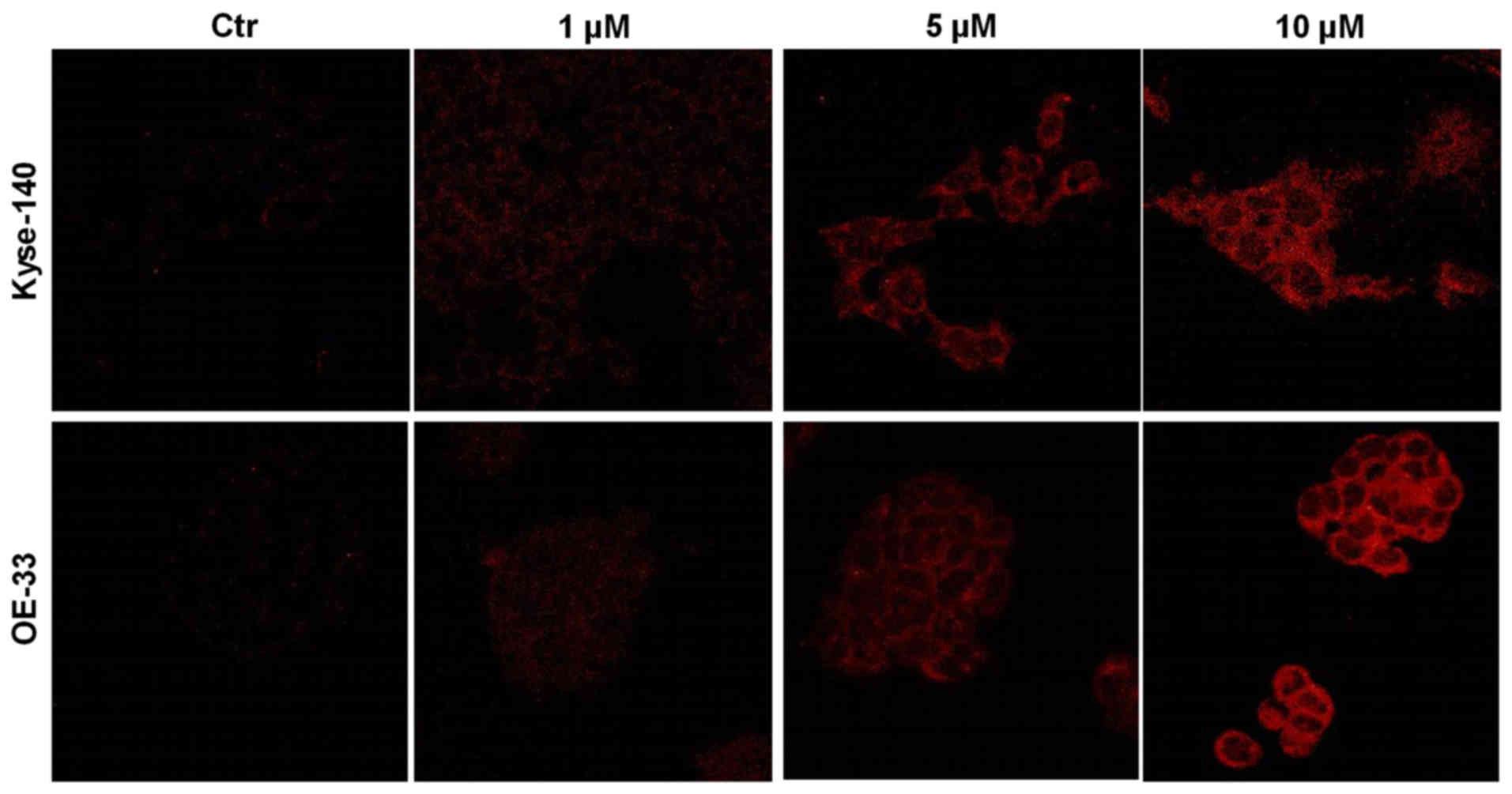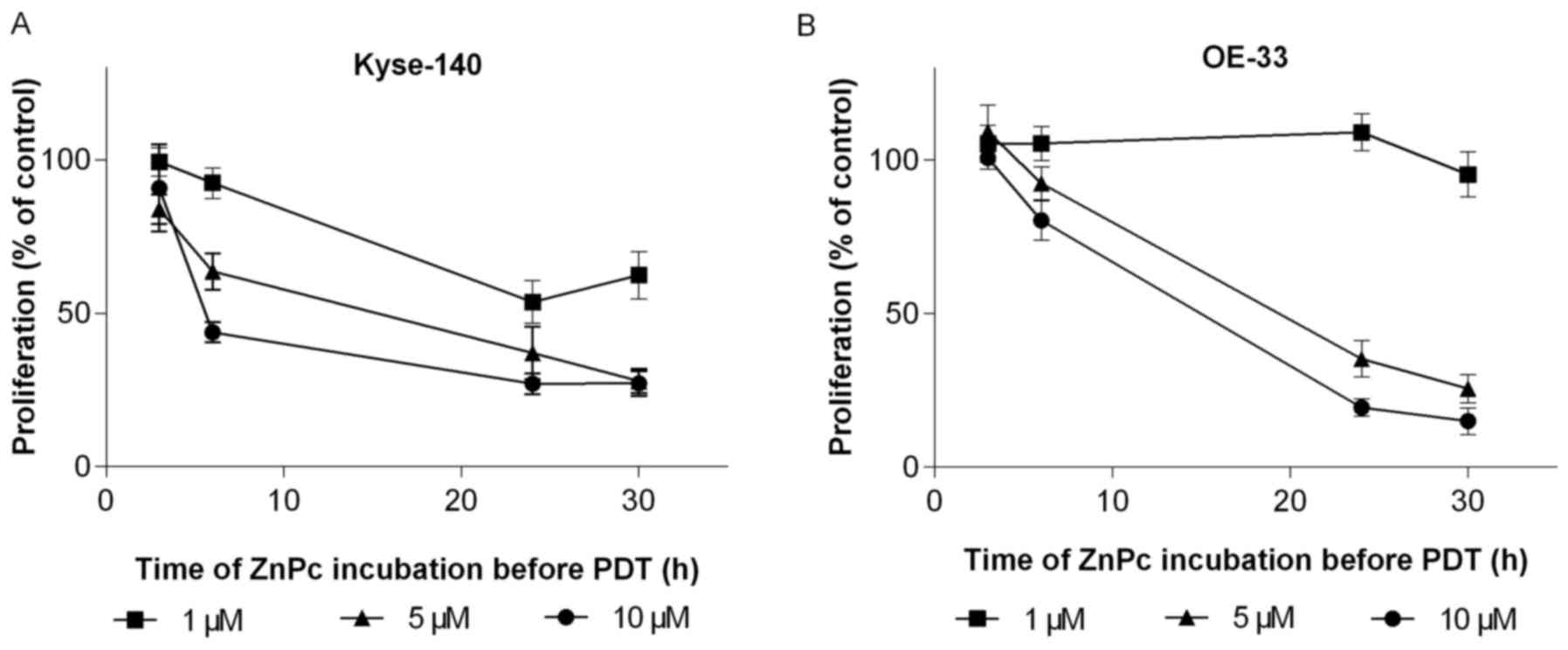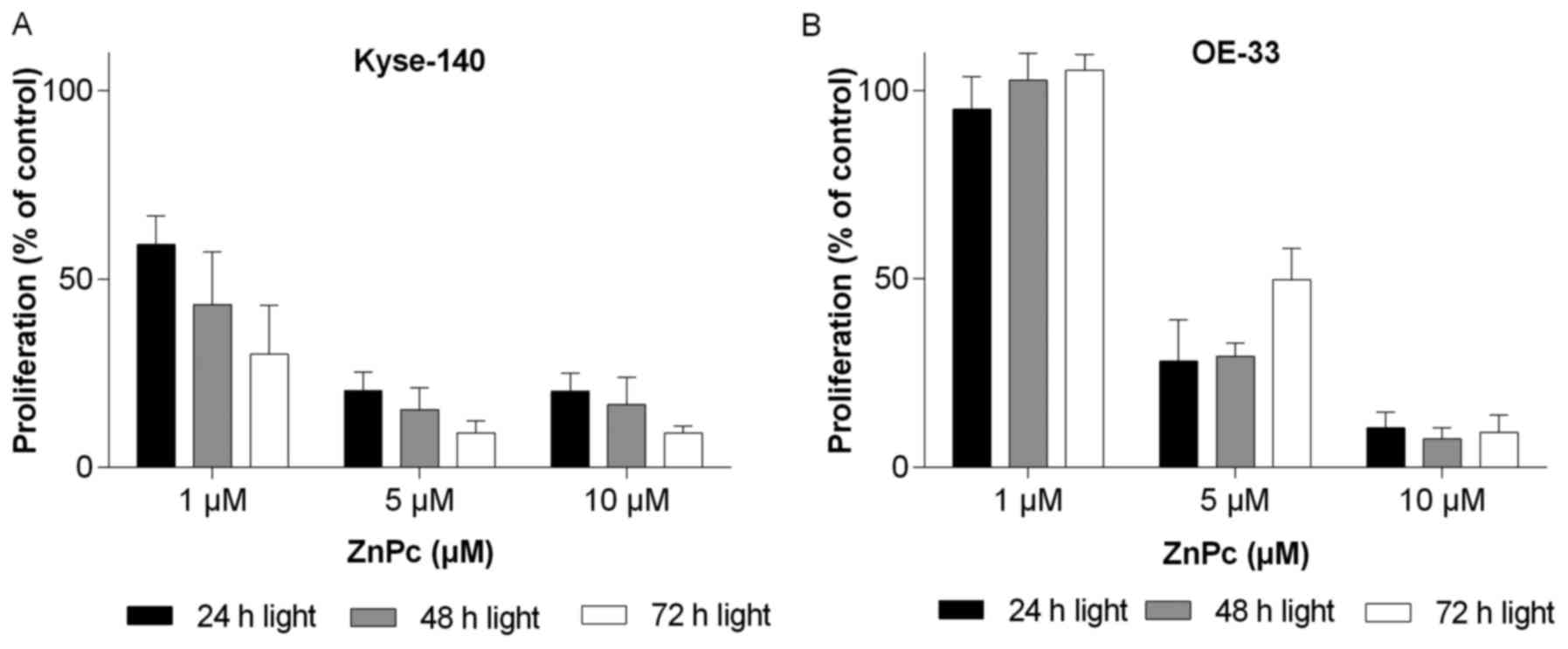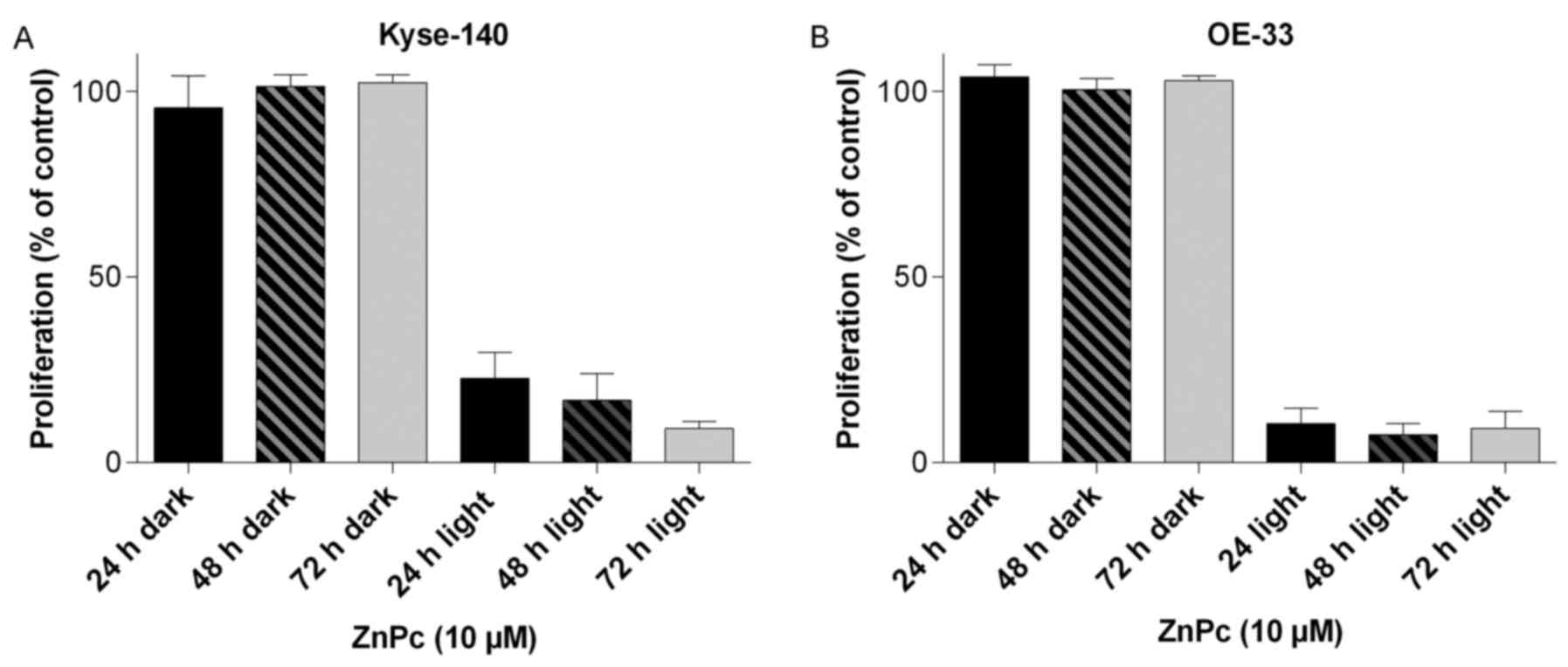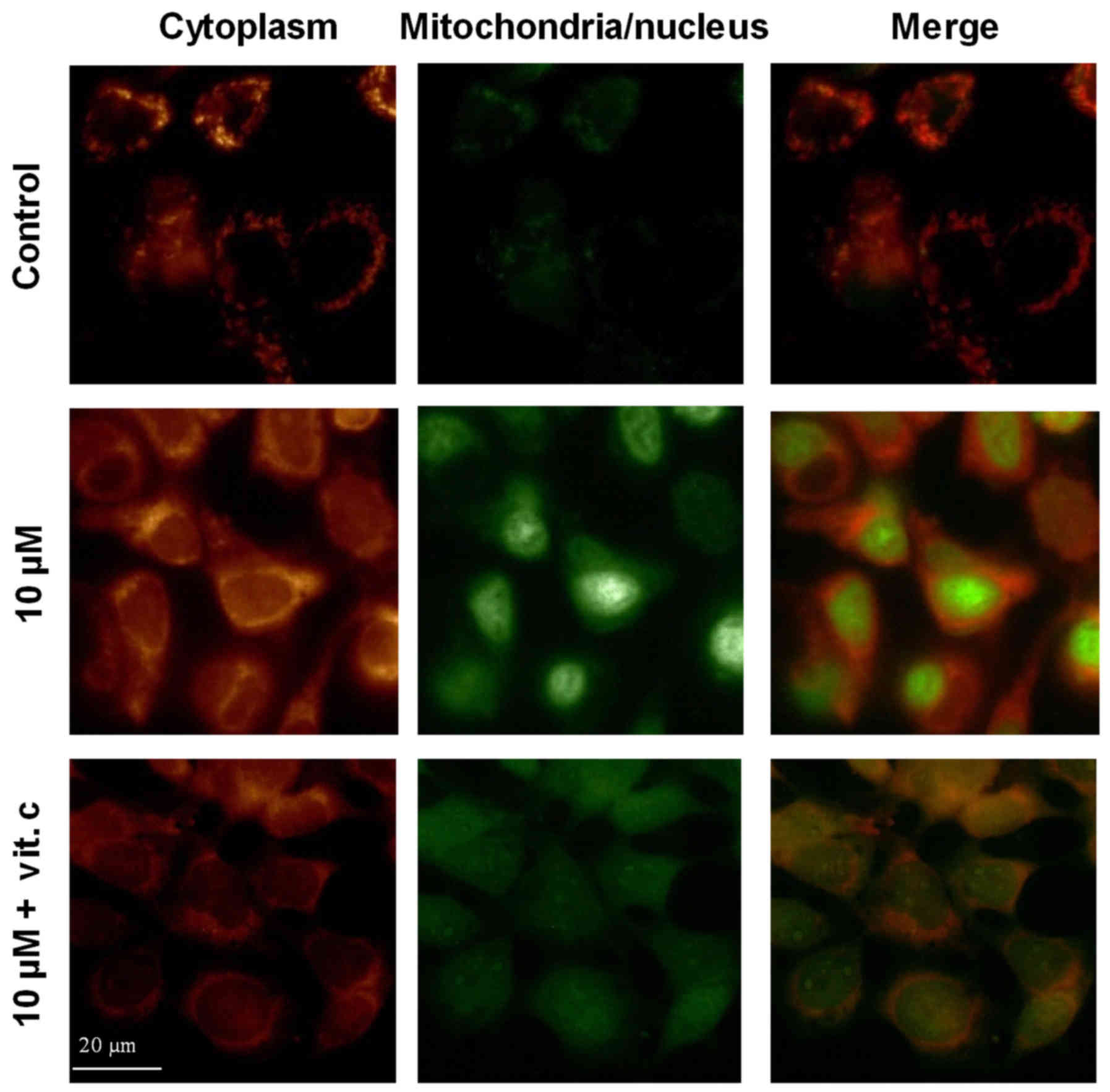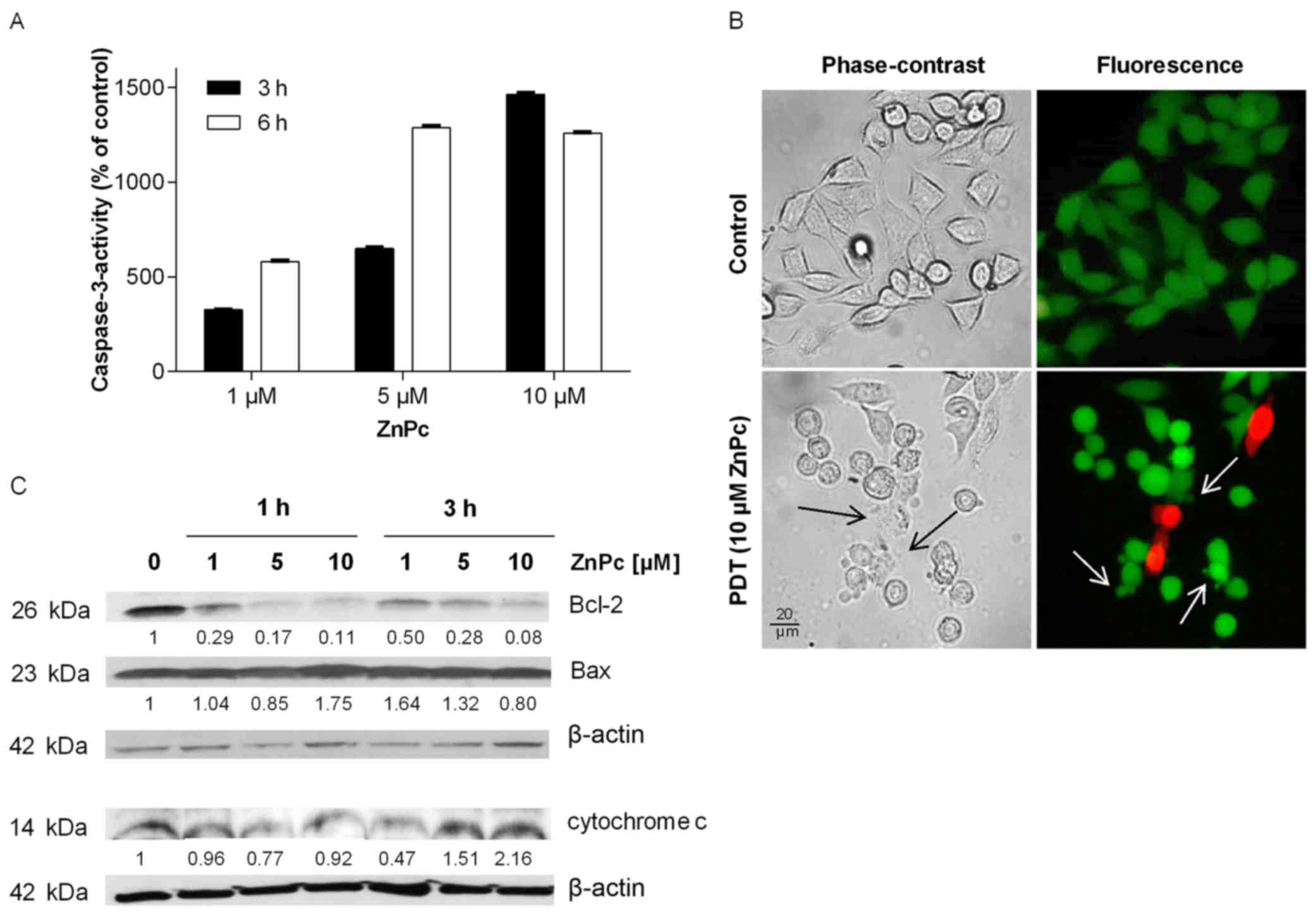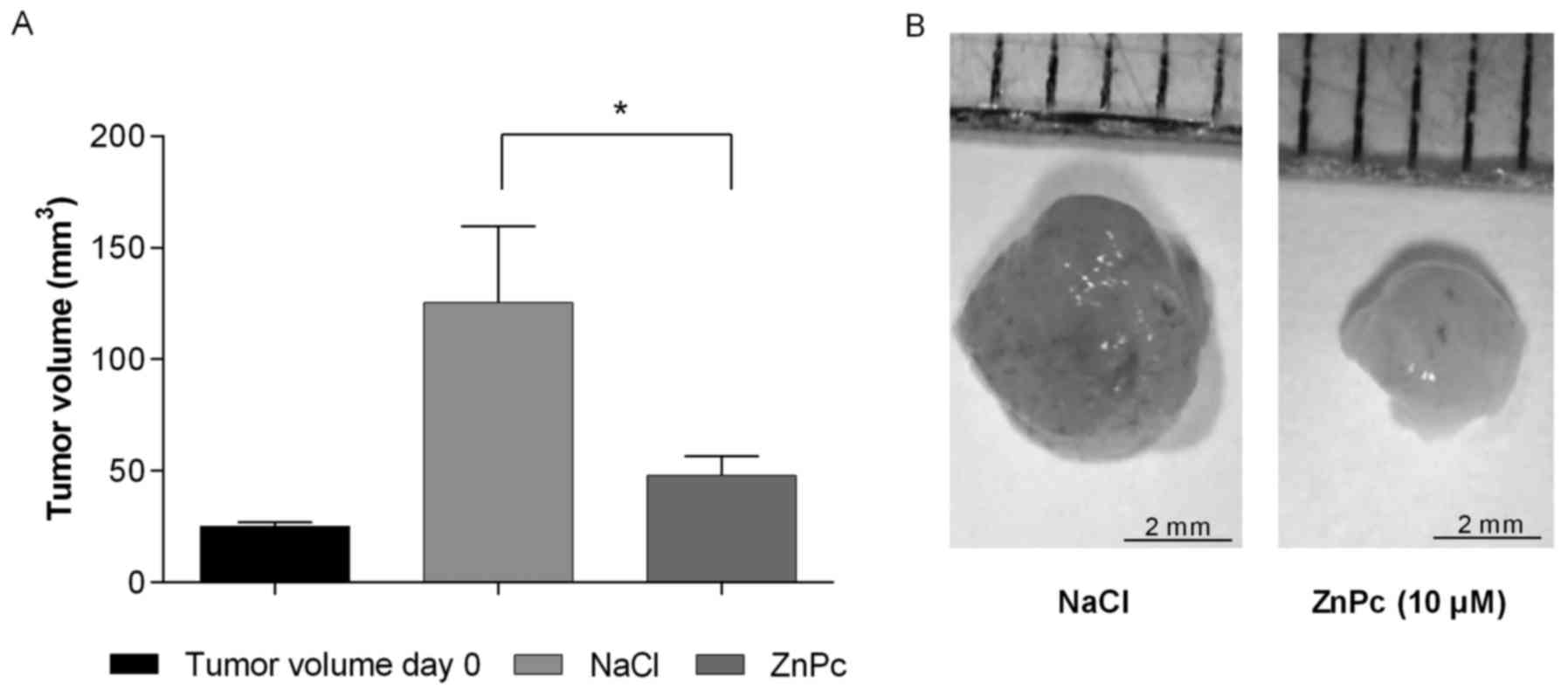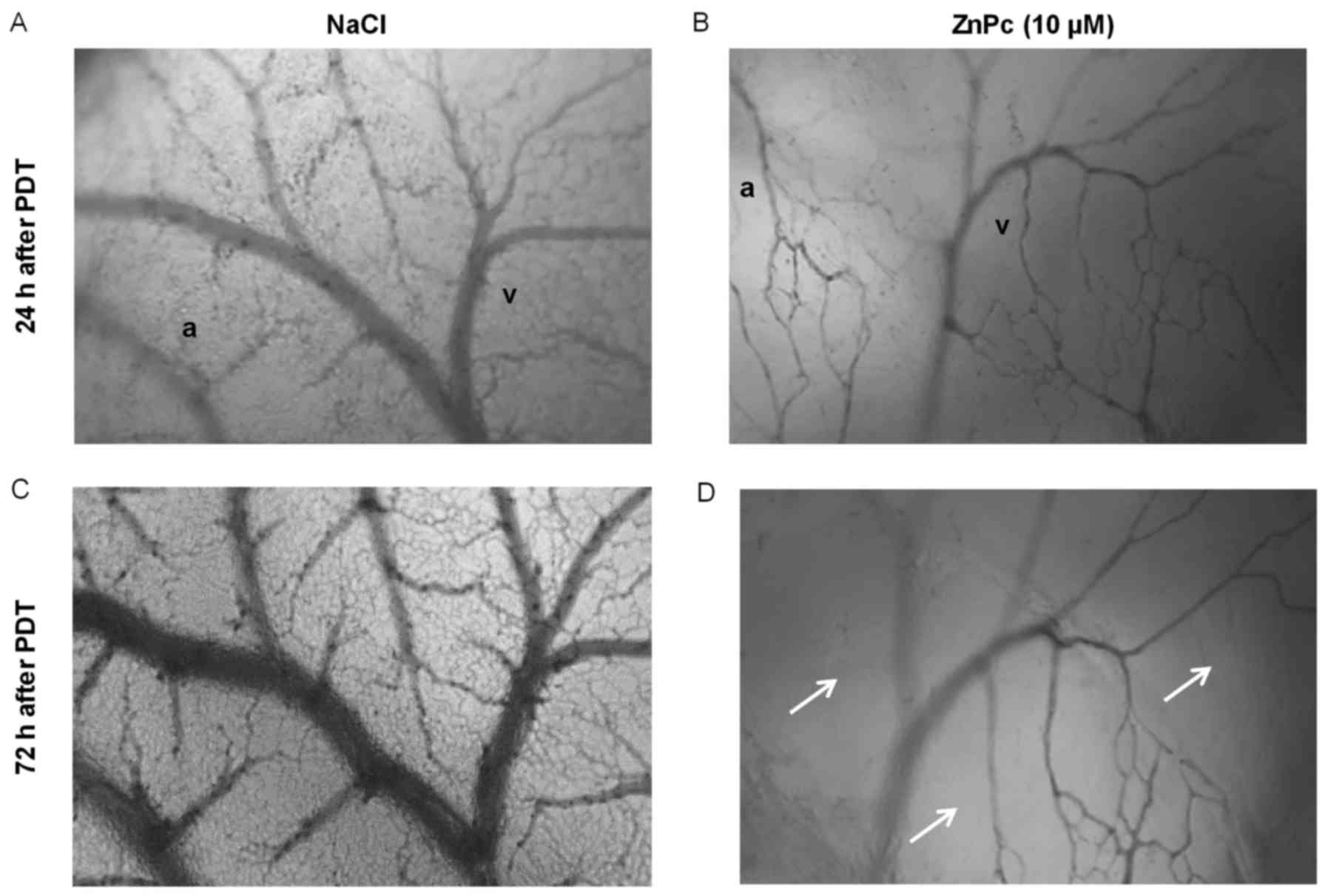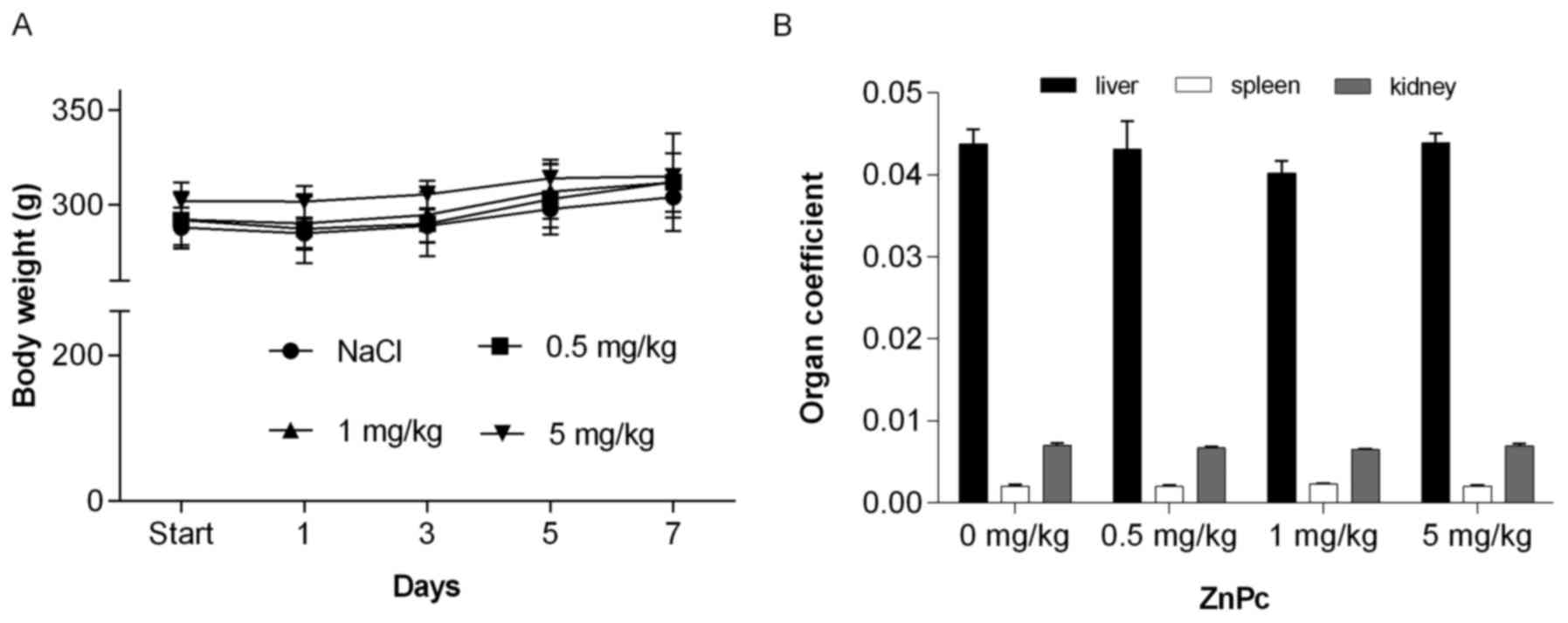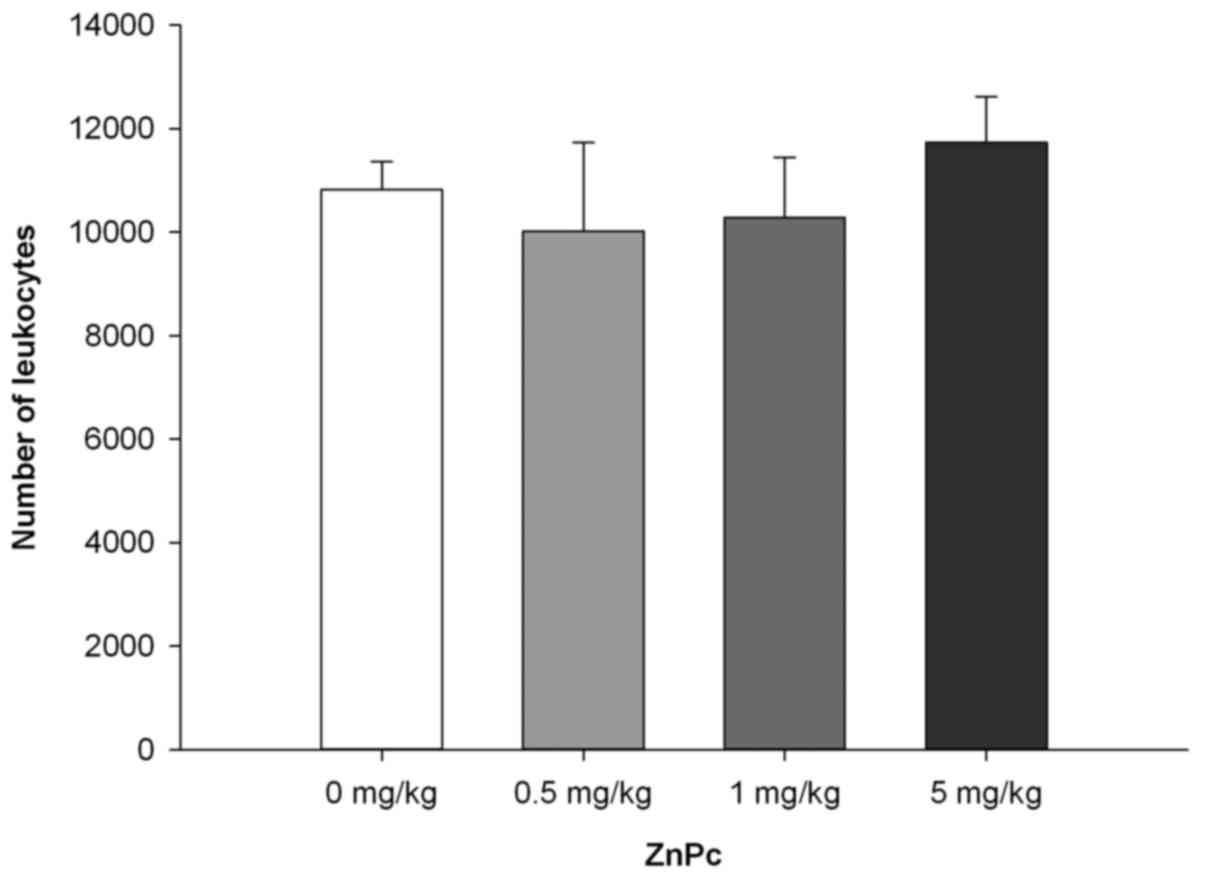Novel zinc phthalocyanine as a promising photosensitizer for photodynamic treatment of esophageal cancer
- Authors:
- Published online on: January 17, 2017 https://doi.org/10.3892/ijo.2017.3854
- Pages: 953-963
Abstract
Introduction
Each year an increasing number of patients is diagnosed with esophageal cancer, which makes it the eight most common cancer worldwide. With almost 500,000 new cases diagnosed and 400,000 deaths in 2012, esophageal cancer is the sixth most common cause of cancer-related death worldwide. The overall 5-year survival rate for patients diagnosed with esophageal cancer is <20% and the current treatment options are far from being satisfactory (1–4). Therefore, innovative approaches are urgently needed (5). In this respect, photodynamic therapy (PDT) has emerged as an effective and supporting modality for gastroenterological and dermatological treatment and has already been shown to be a promising and clinically relevant treatment modality for esophageal neoplasia (6–8).
PDT involves the activation of a photosensitizing drug by irradiation to locally generating reactive oxygen species (e.g., singlet oxygen and superoxide anion radicals) which induces tumor shrinkage by apoptosis and/or necrosis (9,10). Recent developments in synthetic chemistry and optics created new perspectives for the enhancement of the PDT as a promising treatment option. Phthalocyanines are very interesting photoactive substances, which are currently intensively investigated (11–13).
Here, we propose tetra-triethyleneoxysulfonyl substituted zinc phthalocyanine (ZnPc) as a promising photosensitizer for PDT of esophageal cancer. Results of a previous in vitro study already demonstrated a long-lasting elimination of cancer cells of different origin (e.g., pancreatic carcinoid, colorectal carcinoma) (14). This study focused on the photodynamic treatment of esophageal cancer and took both entities, namely squamous cell carcinoma and adenocarcinoma into account to evaluate the potential of this novel ZnPc as a candidate for future PDT treatment of esophageal cancer.
Materials and methods
Photosensitizer
Tetra-triethyleneoxysulfonyl substituted zinc phthalocyanine (ZnPc) was prepared by slightly modifying the procedure described in the literature (15). The compound was dissolved in DMSO of spectroscopic grade (Sigma-Aldrich, France). Concentration of stock solutions was calculated by measuring their optical density at 694 nm with UV/Vis spectrometer Ultraspec 2100 (Amersham Biosciences, UK) and based on Lambert-Beer relationship with ε694 nm = 2.04×105 M/cm (14).
Cell culture
The human esophageal squamous carcinoma cell line Kyse-140 and the human esophageal adenocarcinoma cell line OE-33 were cultured in RPMI-1640 medium (Gibco, Thermo Fisher Scientific, Germany) supplemented with 10% fetal bovine serum (FCS, Biochrom AG, Germany), 100 U/ml penicillin and 100 μg/ml streptomycin (Biochrom AG) (5,9). Medium of OE-33 cells was additionally supplemented with 2 mM L-glutamine (Biochrom AG). All cells were kept under standard conditions (37°C in a humidified atmosphere of 5% CO2). The culture medium was changed every second day and once a week the cells were passaged using 1% trypsin/EDTA.
Light source and irradiation
Cancer cells were irradiated with a broad band light source equipped with a 100 W halogen lamp (EFR 12 V/100 W GZ - 6.35 lamp, Omnilux, Germany). The spectral output of the lamp ranged from 400 to 800 nm. To prevent infrared irradiation, a heat-reflecting filter that cuts off transmission at 700 nm and above was inserted into the optical path. The illuminated area (5.5×4.5 cm) had an average power density of 80 W/m2. The light energy dose was measured with a P-9710 radiometer controlled by a silicon photocell (Optometer P 9710) from Gigahertz-Optik (Munich, Germany). The total light energy dose was calculated by integrating the energy signal over the entire period of irradiation.
Photodynamic therapy
For PDT treatment cells were incubated with ZnPc (1–10 μM) for 1–30 h in the dark at 37°C (5% CO2, humidified atmosphere). Thereafter, the ZnPc-containing medium was replaced by PBS, and cells were irradiated with a light dose of 10 J/cm2. During irradiation the temperature of the samples never exceeded 37°C (temperature was measured with a digital thermometer placed inside of irradiation system). After irradiation PBS was removed and cells were maintained at 37°C in the incubator (5% CO2, humidified atmosphere) in PS-free culture medium. Cytotoxic effects of the PS in the absence of light (dark controls) were determined by treating the samples in the same way except for the irradiation.
Intracellular distribution of ZnPc
Cells grown on glass cover slips, were incubated with increasing concentrations of non- photoactivated ZnPc (1–10 μM) for 24 h and then analyzed by measuring their fluorescence with a confocal laser microscope (Leica, DMI 6000, Germany) [excitation: HeNe laser (633 nm), detection: PMT (400–800 nm)], equipped with 63× glycerin immersion objective. Digital images were processed using the Leica LAS AF Lite software.
Growth inhibitory effects of ZnPc-PDT
Changes in the cell number were investigated by performing crystal violet staining as described previously (16). Briefly, the cells were fixed with 1% glutaraldehyde and stained with 0.1% crystal violet. The unbound dye was removed by washing the cells with water. Bound crystal violet was solubilized with 0.2% Triton-X-100 in PBS. Light extinction, which increases linearly with the cell number, was analyzed at 570 nm using an ELISA-Reader.
Measurement of reactive oxygen species (ROS)
Cells were incubated for 24 h with ZnPc, and then illuminated with 10 J/cm2. ROS formation was determined 24 h later with CellROX Green and CellROX Orange (Thermo Fisher Scientific, USA) according to the manufacturer's protocol. Control cells underwent PDT without previous ZnPc loading. Cells were analyzed by using a fluorescence microscope (Axioskop 40; objective 40×, NA 1.30, Zeiss, Germany) equipped with digital camera (Kappa, DX4-285FW, Germany). Green fluorescence shows ROS formation in nucleus and mitochondria (ex/em ~470/525 nm), orange fluorescence displays ROS in the cytoplasm (ex/em ~546/575 nm). Separate sets of cells were incubated with 1 mM of vitamin C (WEPA, Germany) for 1 h before ZnPc-PDT to suppress ROS formation.
Detection of apoptosis
Changes in caspase-3 activity were calculated from the cleavage of the fluorogenic substrate AC-DEVD-AMC (Calbiochem-Novabiochem, Germany), as described previously (17). Three and 6 h after ZnPc-PDT, cells were lysed with lysis buffer and the lysates were incubated for 1 h at 37°C with a substrate solution containing 20 μg/ml AC-DEVD-AMC, 20 mM HEPES, 10% glycerol, 2 mM DTT at pH 7.5. Substrate cleavage was measured fluorometrically using a VersaFluor fluorometer (Bio-Rad, Germany; filter sets: ex 360/40 nm, em 460/10 nm).
Detection of apoptosis-specific changes in cellular morphology were visualized by using cell viability/cytotoxicity assay kit (Live/dead assay, Life Technologies, USA) as described earlier (18). Six hours after ZnPc-PDT, cells which were grown on cover slips, were incubated with calcein- AM (160 nM) and EthD-1 (2 μM) for 30 min in medium at 37°C and examined by fluorescence microscope from Zeiss (Axioskop 40; objective 20×, 0.50 NA, Zeiss). Live cells were identified by the presence of ubiquitous intracellular esterase activity, leading to the conversion of non-fluorescent cell-permeable calcein-AM to the green-fluorescent polyanionic dye calcein (ex/em 495/510 nm), which is well retained in living cells. Dead cells were determined by EthD-1 (ex/em 495/635 nm), which becomes red-fluorescent upon binding to nucleic acids of cells with damaged membranes.
Changes in Bcl-2 and Bax expression, and release of cytochrome c from PDT-damaged mitochondria, indicating the induction of mitochondria mediated apoptosis was analyzed by western blotting as described previously (19). In brief, whole-cell extracts were prepared by lysing cells with RIPA-buffer Cell lysates containing 30 μg protein were subjected to gel electrophoresis (12% gel for Bcl-2 and Bax, 4–20% gel for cytochrome c, Bio-Rad, USA). Proteins were transferred to PVDF membranes by electroblotting for 1.5 h at 100 V. The blots were blocked in 5% non-fat dry milk in TBS-Tween solution for 1 h at room temperature, and then incubated at 4°C overnight with antibodies directed against anti-human Bcl-2 (1:500) (Santa Cruz, USA), Bax (1:500) (Cell Signaling, USA), cytochrome c (1:1,000) (Cell Signaling) and anti-β-actin (1:2,000) (Sigma, USA) as loading control. After incubation with horseradish peroxidase-coupled anti-IgG antibodies (1:10,000, Amersham) for ≥1 h at room temperature, the blots were developed and visualized by using enhanced chemiluminescent detection kit (Amersham) and exposed to ECL Hyperfilm.
Antitumoral and antiangiogenic effects of ZnPc-PDT
In vivo studies on the antitumoral and antiangiogenic effects of ZnPc-PDT were performed by using chicken chorioallantoic membrane assays (CAM) as described previously (14,20).
Kyse-140 cells (1×106) were resuspended in 10 μl cell culture medium and mixed with 10 μl Matrigel (Corning, MA, USA). Cell suspensions were pipetted into silicone ring (5 mm 0) that was placed on the CAM of fertilized chicken eggs on day 7 of development. The tumor plaques were allowed to adhere for 72 h before they were topically treated with 10 μl of ZnPc (10 μM) or NaCl 0.9% (as negative control). Thereafter eggs were sealed with clear tape and incubated in the dark at 37°C in a humidified incubator. Twenty-four hours later tumors were illuminated with 10 J/cm2. Tumor growth and viability of the developing embryo were controlled daily by stereo microscopy (up to 72 h after treatment). At the end of the experiment, tumors were resected, measured - (largest diameter)2 × (perpendicular diameter) × 0.5 and photographed with stereo-microscope equipped with camera (Di-Li, digital microscope, Germany) (21).
For the antiangiogenic testing of ZnPc-PDT, 10 μl of ZnPc (10 μM) or 10 μl NaCl 0.9% (as negative control) were topically applied inside of a silicone ring (5 mm Ø) that was placed on the CAM of fertilized chicken eggs at day 11 of the chicken embryo development. Thereafter eggs were sealed with clear tape and incubated in the dark at 37°C in a humidified incubator. Twenty-four hours later the treated areas were illuminated with 10 J/cm2. Changes in the microvasculature of the CAM were recorded 24 and 72 h after PDT by using a stereo microscope (Axioplan; Zeiss) equipped with a digital camera (MBF, Bioscience, USA).
Biotolerability of non-photoactivated ZnPc in vivo
Safety of non-photoactivated ZnPc in vivo was examined in male Wistar rats (n=15, weight 290±6 g; 11-week-old) (22). Influence of the PS on the immune system and organs such as liver or kidneys were examined to monitor the potential dark toxicity of the compound. Rats were divided into four treatment groups: group I, negative control, 0.9% saline, n=3; groups II-IV, 0.5, 1 and 5 mg/kg, n=4/per group). ZnPc or saline were injected intraperitoneally. Rodent cages were partly covered with light-impermeable fabric. Body weight, behavior, food and water consumption were controlled each day. After sacrificing the animals on day 7, liver, kidney, and spleen were weighed to calculate the organ coefficient [rat weight (g)/organ weight (g)] (23). The amount of white blood cells (WBC) in the blood was determined by using a hematology analyzer (Cell-Dyn 3700, USA). Identification of leukocyte subsets (lymphocytes, monocytes, neutrophils, eosinophils) was performed by using Aerospray Slide Stainer 7120 (Wescor, USA). All animal experiments were conducted under the authority of the Local Ethics Committee for the Care and Use of Laboratory Animals of the Medical University of Gdansk, Poland.
Results
Uptake of ZnPc
Intracellular localization of increasing concentrations of ZnPc in cancer cells was investigated using confocal laser scanning microscopy. ZnPc-loaded Kyse-140 and OE-33 cells showed a dose-dependent uptake and homogenous cytoplasmic distribution of non-photoactivated ZnPc after 24 h of incubation (Fig. 1).
Determination of ZnPc-induced phototoxicity
Changes in the cell number of Kyse-140 and OE-33 cells after treatment with non- and photoactivated ZnPc (1–10 μM) were analyzed by crystal violet staining.
To establish the optimal loading time of ZnPc, esophageal cancer cells were incubated for 1–30 h with rising concentrations of ZnPc (1–10 μM). The subsequent PDT (10 J/cm2) showed a strong correlation between loading time and growth rate of ZnPc-PDT treated cells. The longer the incubation time, the more pronounced was the ZnPc-PDT induced growth inhibition, reaching its maximum after 24 h of incubation. No further increase was observed when the incubation time was prolonged to 30 h. Squamous esophageal cancer cells (Kyse- 140) were more sensitive (Fig. 2A) than adenocarcinomatous OE-33 cells which required higher ZnPc-concentrations for pronounced growth inhibitory effects (Fig. 2B). Additional experiments on Kyse-140 using the RTCA iCELLigence system (ACEA, Bioscences, USA), confirmed the proliferation data (24). This system monitors the proliferation of ZnPc-PDT treated cells in real-time. Photodynamic treatment caused a 68% decrease in the cell index (value calculated from changes in the electrical impedance, which correlates with changes in cell numbers) of cancer cells preincubated with ZnPc (5 μM) at least 24 h before PDT (data not shown).
To measure the time course of growth inhibition of ZnPc-PDT treated Kyse-140 and OE-33 cells (preincubated with ZnPc for 24 h), cell proliferation was examined for up to 72 h after photoactivation of ZnPc. Photoactivation of ZnPc (10 J/cm2) resulted in a significant dose- and time-dependent decrease in cell proliferation of Kyse-140 (Fig. 3A) and OE-33 (Fig. 3B) of >90% as compared to untreated control cells. The phototoxic effects of ZnPc-PDT was more pronounced in squamous Kyse-140 cancer cells than in adenocarcinomatous OE-33 cells, which is reflected in the respective IC50-values of 1.41±0.40 μM (Kyse-140) and 3.35±0.79 μM (OE-33). Moreover, at least the Kyse-140 cells that escaped from being killed by low dose ZnPc-PDT (1 μM) did not regenerate (re-proliferate) in the following days (Fig. 3A).
Checking for dark toxic effects of ZnPc, changes in the cell number and morphology of Kyse-140 and OE-33 cells loaded with ZnPc (1–10 μM) were determined for up to 72 h after the incubation period. Even at concentrations as high as 10 μM, no decrease in cell number (Fig. 4) nor changes in the morphology (data not shown) of either esophageal cancer cell model could be observed, showing the non-toxic nature of the non-illuminated compound.
Induction of ROS formation by ZnPc-PDT
One of the underlying mechanisms of photodynamic therapy is the generation of highly reactive oxygen species (ROS) and free radicals upon photoactivation of the PS, thereby damaging the membranes of the cell and its organelles (e.g., mitochondria, Golgi vesicles, ribosomes) which subsequently leads to severe cell injury and death. ZnPc-PDT-induced formation of ROS was evaluated by fluorescence microscopy employing dyes that monitor ROS formation in the cytoplasm (orange fluorescence) or in the nucleus/mitochondria (green fluorescence). Twenty-four hours after ZnPc-PDT a robust increase in ROS formation was observed in either Kyse-140 (Fig. 5) or OE-33 cells. ROS formation occurred ubiquitously and without a preferred localization in the nucleus or mitochondria, as in both cell lines there was a similar increase in ROS formation in the nucleus/mitochondria as well as in the cytoplasm. To further confirm ROS formation after ZnPc-PDT, Kyse-140 cells were incubated with the antioxidant and free radical scavenger vitamin C (1 mM) prior to PDT. One hour preincubation with vitamin C caused an appreciable decrease of free radical formation in the cytoplasm as well as in the nucleus/mitochondria (Fig. 5).
Apoptotic effect of ZnPc-PDT
Photodynamic treatment can lead to the induction of apoptosis by ROS-mediated disturbance of mitochondrial integrity. The molecular mechanism underlying the ZnPc-PDT induced apoptosis and changes in cell morphology of Kyse-140 were analyzed for up to 6 h after PDT.
ZnPc-PDT caused time- and dose-dependent increase of caspase-3-activity, which was measured by performing caspase-3 assays. ZnPc-PDT treated cells showed an increase in caspase-3 activity of up to 15-fold higher as compared to untreated, but illuminated control cells (Fig. 6A). Employing fluorescence microscopy apoptosis-related changes in cell morphology were determined 24 h after PDT. Cells appeared shrunken and unstructured with simultaneous formation of membrane-bound apoptotic bodies (Fig. 6B). As caspase-3 can be activated by either mitochondria-dependent or -independent signaling pathways, we checked the expression of Bax, Bcl-2 and cytochrome c to confirm the hypothesis that PDT-induced apoptosis was mitochondria driven because of ROS induced disturbance of mitochondrial integrity. One hour after ZnPc-PDT the expression of antiapoptotic Bcl-2 decreased dose-dependently with a simultaneous increase of proapoptotic Bax. Three hours after ZnPc-PDT an increase in cytochrome c expression was observed (Fig. 6C). Cytochrome c is released from the mitochondrial intermembrane into the cytosol during apoptosis further indicating mitochondria-dependent apoptosis.
Antitumor and antiangiogenic activity of ZnPc-PDT in vivo
Antineoplastic effects of the novel ZnPc-PDT was studied in vivo by employing CAM-assays. Tumor plaques (1×106 cancer cells) grown from squamous cell carcinoma (Kyse-140) were inoculated onto the CAM of 7-day-old fertilized chicken eggs. The plaques got attached to the microvessel network of the CAM after 72 h and thereafter were topically treated with ZnPc (10 μM) for 24 h and illuminated (10 J/cm2). Seventy-two hours post PDT, tumors were excised, photographed and changes in tumor volume was determined. Photodynamic treatment led to a significant reduction of tumor growth of >70% after 3 days when compared to control experiments, in which the tumors were also illuminated with 10 J/cm2 but treated with NaCl instead of ZnPc (Fig. 7).
The antiangiogenic effects of ZnPc-PDT on the microvessel formation were examined on the developing CAM for ≤ 72 h after treatment. An area of 5 mm Ø of 11-day-old CAMs was incubated with 10 μM ZnPc for 24 h and then illuminated (10 J/cm2). ZnPc-PDT led to an increase of non-perfused areas and to vasodegeneration of the vasculature and the capillary plexus. NaCl treated and illuminated control CAMs showed no changes in the vascular network, which still consisted of a continuously perfused capillary plexus and larger vessels (arteries and veins). The antiangiogenic changes of ZnPc-PDT were still evident after 72 h indicating a lasting antiangiogenic effect of the treatment in vivo (Fig. 8).
Safety of non-illuminated ZnPc in vivo
Prior to animal experiments with the novel ZnPc-PDT, we performed a set of experiments evaluating the so-called 'dark toxicity' of the novel photosensitizer in vivo to get valuable information on its systemic effects in living organisms as well on its expected clinical safety.
Injection of 10 μl ZnPc (10 μl of 10 μM) into an embryofeeding vein of the chorioallantoic membrane at day 14 of embryonic development did not influence the survival or further embryonic development. Twenty-four hours after ZnPc injection, 100% of the 6 injected chicken embryos survived (data not shown), further supporting the expected safety of the novel photosensitizer in its non-photoactivated state.
Based on the promising in vitro findings (Fig. 4) and the aforementioned in vivo results, we performed first animal studies on Wistar rats. The rats were injected intraperitoneally with rising doses of ZnPc (0.5–5 mg/kg) and kept in light-protected rodent cages for one week. During the entire observation period the animals constantly kept or even slightly gained weight (Fig. 9A), behaved normally, and did not show any changes in food and water consumption, as compared to the saline treated control animals. At the end of the experiment, several organs (liver, spleen, and kidney) were removed and weighed, also blood samples were taken for blood analysis. None of the analyzed organs were swollen or shrunken which is reflected by the constant organ coefficient (Fig. 9B). No significant changes in leukocyte number (Fig. 10) or leukocyte subsets (data not shown) of photosensitizer-treated animals were observed, indicating that non-photoactivated ZnPc is generally well-tolerated and does not induce systemic inflammation.
Discussion
Medical therapy of advanced esophageal cancer is still unsatisfactory. Moreover, many patients with esophageal cancer are in poor clinical condition precluding aggressive chemotherapy (5). Thus, there is a strong need for new, effective and well-tolerated treatment approaches. An interesting alternative approach may be photodynamic therapy (PDT) which is already in clinical use for the treatment of Barret's dysplasia and esophageal cancer (25–28). Besides elimination of the neoplastic tissue, PDT treatment may also decrease the risk of esophageal stricture and perforation. Moreover, technological improvements (e.g., light emitting fabrics or optical fibers), enabled a rapid progress in the field of PDT (29). However, there is still a need for new and highly effective photosensitizers. In a previous study we proposed tetra-triethyleneoxysulfonyl-substituted zinc phthalocyanine as a promising photosensitizer for photodynamic treatment of different types of gastrointestinal cancer (14). In this study, we focused on the suitability and effectiveness of a PDT treatment with the novel ZnPc in human esophageal cancer of either adenocarcinomatous or squamous cell carcinomatous histology.
PDT efficiency is highly dependent on the photophysical properties of the employed PS as well as on its intracellular accumulation and distribution in the target cells/tissue (30,31). For example, Shao et al and Tynga et al showed that comparable ZnPc primarily accumulates in mitochondria and lysosomes (32,33). Employing confocal laser microscopy, we could demonstrate a time- and dose-dependent uptake of non-photoactivated ZnPc in esophageal cancer cells of both entities. However, in contrast to the above-mentioned studies, we observed rather homogeneous cytoplasmic distribution of PS in both cell lines. Nonetheless, photoactivation of ZnPc caused ROS formation not only in the cytoplasm but also in mitochondria and nucleus, pointing to its high phototoxic potential.
The particular PDT protocols have a great impact on the therapy outcome and differ from one cancer type to another (34,35). The time interval between the application of a photosensitizer and subsequent PDT is very important due to the different intracellular uptake kinetics of each particular photosensitizer (36). To estimate the optimal incubation time of ZnPc in esophageal cancer cells, different pre-incubation times (1–30 h) were evaluated. We could show that approximately 24 h were required to achieve pronounced antineoplastic PDT-effects with ZnPc concentrations as low as 1 μM in EC cells. Prolonging the incubation time to >24 h did not further enhance the PDT outcome at this concentration, but the data also showed that at higher concentrations of the PS (5 μM) comparable results were achieved with much shorter pre-incubation times of only 10 h. Thus for the determination of optimal treatment protocols for patients, it will be interesting to figure out the reasonable compromise between a preferably short preincubation time and a well-tolerated but still highly effective PS concentration.
To estimate the cytotoxic potential of ZnPc-PDT, proliferation studies were performed. We observed a significant decrease in the cell number of esophageal adeno- and squamous cell carcinoma cells of ≥90% after ZnPc-PDT, showing that the treatment is working well in both histologies. Kyse- 140 cells seemed to be even more susceptible to the treatment, as shown by the lower IC50-value of ZnPc of 1.41 μM, as compared to 3.35 μM in OE-33 cells. Another difference between squamous and adenocarcinoma cells became apparent when looking at the longevity of the PDT-induced growth inhibition. While squamous Kyse-140 cells which escaped from being immediately killed by the initial PDT treatment did not seem to be able to (re-)proliferate in the following days, PDT-surviving adenocarcinomatous OE-33 cells started to re-grow 48 h after treatment. This effect could be compensated by using higher concentrations of PS for the specific cell line. Further studies are required to reveal if specific cellular responses e.g., cell cycle regulation might play a role in the different behavior of the two cell types and the respective mode of action.
Generation and localization of free radicals and singlet oxygen species have a strong influence on the efficiency of PDT (37). Here, we demonstrated ROS formation in esophageal cancer cells by ZnPc-PDT for the first time. By employing green and orange fluorescent dyes, which distinguish between free radical formation and localization in the cytoplasm (orange) or cell organelles such as the mitochondria or the nucleus (green), we observed a dose-dependent production of ROS after ZnPc-PDT in both esophageal carcinoma entities. Prominent increases in the ROS production of Kyse-140 and OE-33 cells resulted in cell death rates of 70–90% already 24 h after PDT. The increase in green fluorescence indicates ROS formation near or in the nucleus and mitochondria. This notion may be of importance when deciphering the underlying signaling events and pathways of ZnPc-PDT in terms of apoptosis (38). Nucleus and mitochondria specific ROS formation was partially blocked by pre-incubation with the antioxidant vitamin C, supporting the idea that ROS formation may be of particular importance for the antiproliferative effects of the novel photosensitizer. This is consistent with the findings of Grimm et al who investigated the influence of different exogenous antioxidants on melanoma cell proliferation after PDT with 5-aminolevulinic acid (5-ALA) (39). After exposure to 5-ALA, human melanoma cells were incubated with vitamin C at different doses and then irradiated with light followed by a significant decrease of the cell death rate.
In the last decade, a significant progress has been made in the development of apoptosis-modulating cancer therapeutics which are currently examined in several human clinical trials (40). Most importantly, the induction of apoptosis, unlike necrosis, does not cause inflammation and is thus preferred over cytotoxic and necrotic treatment strategies (30,41). It has been shown that PDT can induce apoptosis and in a previous study we demonstrated that ZnPc-PDT induced apoptotic cell death of gastrointestinal cancer cells. However, it was unclear whether extrinsic or intrinsic apoptotic pathways were involved (14). In this study we investigated the changes in the expression of proteins associated with mitochondria-driven apoptosis. Photoactivated ZnPc caused a downregulation of antiapoptotic Bcl-2 and a concomitant upregulation of proapoptotic Bax. Importantly, an increase in cytochrome c was detected. Together with the marked increase in caspase-3 activity, the data indicated that ZnPc-PDT induces a mitochondria-dependent, intrinsic induction of apoptosis in esophageal cancer cells (38).
The main goal of PDT treatment is the elimination of the neoplastic tissue. Numerous studies on new photosensitizers showed their efficiency to eliminate cancer cells in vitro (33,42,43). However, the therapeutic potential and suitability of a new PS can only be assessed in a combination of in vitro and respective in vivo studies. In our in vivo model (CAM-assay), we showed strong antitumor effects of photoactivated ZnPc on esophageal tumor plaques, which were significantly smaller (>70%) than ZnPc-untreated control tumors (44). Based on the encouraging data, it is at least conceivable that ZnPc-PDT will show equivalent effectiveness in animal models.
Destructive effects of PDT on the microvasculature are well known and have been successfully used for the treatment of choroidal neovascularization or age-related macular degeneration (45,46). In oncology, damage of tumor vascularity and blood flow stasis are significant aspects of PDT that contribute to tumor regression (47). However, it has been reported by Weiss et al that PDT-damaged vasculature can regenerate within 48 h after PDT (21,45). Here, we also demonstrated that ZnPc-PDT exerts a destructive influence on the blood vessel formation and the microvasculature, but in contrast to the findings by Weiss et al these effects were comparably long-lasting, as even 72 h after treatment no regeneration of the vascular network of the CAM could be observed. Long-lasting antiangiogenic effects of enhanced PDT-treatment with ZnPc may be of particular importance if looking for suitable combination treatments in which the PDT is combined with chemotherapeutics that are antiangiogenic or whose antineoplastic potency depends on an antiangiogenic environment (48).
Last but not least, clinical safety, good tolerability and absence of toxicity in its non-photoactivated state (dark toxicity) are important features of appropriate photosensitizers. Checking for dark toxic effects of the novel ZnPc in vitro and in vivo, we showed that non-photoactivated ZnPc does not affect cell survival or proliferation nor does it exhibit any sign of toxicity in in vivo experiments. Testing embryonic survival of fertilized chicken eggs after intravenous application of ZnPc did not lead to signs of toxicity either. Embryonic development as well as survival was not even affected by the highest doses of ZnPc. In line with comparable results of Zhang et al, who investigated dark toxic effects of phthalocyanines we felt encouraged to perform first animal tests (22). Young Wistar rats injected with ZnPc (0.5–5 mg/kg bodyweight) did not show signs of dark toxicity or incompatibility towards the non-photoactivated compound. All animals behaved normally, did not show changes in water or food consumption and did not lose but even slightly gained weight during the experiment. Even more important, the white blood cell count of ZnPc-treated animals did not differ significantly from control animals. Moreover, no changes in the organ coefficients were observed, indicating that no inflammatory processes or organ specific disturbances occurred. Taken together, the novel photosensitizer ZnPc appears to have an excellent biotolerability thus rendering it an interesting photosensitizer for further in vivo studies.
In conclusion, in this study we showed the extraordinary potential of ZnPc for PDT-treatment of esophageal cancer. Further in vivo investigations are warranted to estimate antitumor activity of photoactivated ZnPc in animal models.
Acknowledgments
Weronika Kuzyniak was funded by a scholarship of the Studienstiftung des deutschen Volkes. Gustav Steinemann was supported by a scholarship of the FAZIT-Stiftung, Frankfurt a. M., Germany. Jacob Schmidt was funded by a scholarship of the Berliner Krebsgesellschaft e.V.
References
|
Thrift AP: The epidemic of oesophageal carcinoma: Where are we now? Cancer Epidemiol. 41:88–95. 2016. View Article : Google Scholar : PubMed/NCBI | |
|
Ireland CJ, Thompson SK, Laws TA and Esterman A: Risk factors for Barrett's esophagus: A scoping review. Cancer Causes Control. 27:301–323. 2016. View Article : Google Scholar : PubMed/NCBI | |
|
Meves V, Behrens A and Pohl J: Diagnostics and early diagnosis of esophageal cancer. Viszeralmedizin. 31:315–318. 2015. View Article : Google Scholar | |
|
Chang TL, Tsai YF, Chao YK and Wu MY: Quality-of-life measures as predictors of post-esophagectomy survival of patients with esophageal cancer. Qual Life Res. 25:465–475. 2016. View Article : Google Scholar | |
|
Sutter AP, Höpfner M, Huether A, Maaser K and Scherübl H: Targeting the epidermal growth factor receptor by erlotinib (Tarceva) for the treatment of esophageal cancer. Int J Cancer. 118:1814–1822. 2006. View Article : Google Scholar | |
|
Triesscheijn M, Baas P, Schellens JHM and Stewart FA: Photodynamic therapy in oncology. Oncologist. 11:1034–1044. 2006. View Article : Google Scholar : PubMed/NCBI | |
|
Yi E, Yang CK, Leem C, Park Y, Chang J-E, Cho S and Jheon S: Clinical outcome of photodynamic therapy in esophageal squamous cell carcinoma. J Photochem Photobiol B. 141:20–25. 2014. View Article : Google Scholar : PubMed/NCBI | |
|
Shishkova N, Kuznetsova O and Berezov T: Photodynamic therapy in gastroenterology. J Gastrointest Cancer. 44:251–259. 2013. View Article : Google Scholar : PubMed/NCBI | |
|
Höpfner M, Maaser K, Theiss A, Lenz M, Sutter AP, Kashtan H, von Lampe B, Riecken EO, Zeitz M and Scherübl H: Hypericin activated by an incoherent light source has photodynamic effects on esophageal cancer cells. Int J Colorectal Dis. 18:239–247. 2003.PubMed/NCBI | |
|
Castano AP, Demidova TN and Hamblin MR: Mechanisms in photodynamic therapy: Part one-photosensitizers, photochemistry and cellular localization. Photodiagn Photodyn Ther. 1:279–293. 2004. View Article : Google Scholar | |
|
Liu M, Tai C, Sain M, Hu AT and Chou F: Photodynamic applications of phthalocyanines. J Photochem Photobiol Chem. 165:131–136. 2004. View Article : Google Scholar | |
|
Josefsen LB and Boyle RW: Photodynamic therapy: Novel third- generation photosensitizers one step closer? Br J Pharmacol. 154:1–3. 2008. View Article : Google Scholar : PubMed/NCBI | |
|
Jiang Z, Shao J, Yang T, Wang J and Jia L: Pharmaceutical development, composition and quantitative analysis of phthalocyanine as the photosensitizer for cancer photodynamic therapy. J Pharm Biomed Anal. 87:98–104. 2014. View Article : Google Scholar | |
|
Kuzyniak W, Ermilov EA, Atilla D, Gürek AG, Nitzsche B, Derkow K, Hoffmann B, Steinemann G, Ahsen V and Höpfner M: Tetra-triethyleneoxysulfonyl substituted zinc phthalocyanine for photodynamic cancer therapy. Photodiagn Photodyn Ther. 13:148–157. 2016. View Article : Google Scholar | |
|
Atilla D, Saydan N, Durmuş M, Gürek AG, Khan T, Rück A, Walt H, Nyokong T and Ahsen V: Synthesis and photodynamic potential of tetra- and octa-triethyleneoxysulfonyl substituted zinc phthalocyanines. J Photochem Photobiol Chem. 186:298–307. 2007. View Article : Google Scholar | |
|
Nitzsche B, Gloesenkamp C, Schrader M, Ocker M, Preissner R, Lein M, Zakrzewicz A, Hoffmann B and Höpfner M: Novel compounds with antiangiogenic and antiproliferative potency for growth control of testicular germ cell tumours. Br J Cancer. 103:18–28. 2010. View Article : Google Scholar : PubMed/NCBI | |
|
Gloesenkamp C, Nitzsche B, Lim AR, Normant E, Vosburgh E, Schrader M, Ocker M, Scherübl H and Höpfner M: Heat shock protein 90 is a promising target for effective growth inhibition of gastrointestinal neuroendocrine tumors. Int J Oncol. 40:1659–1667. 2012.PubMed/NCBI | |
|
Höpfner M, Huether A, Sutter AP, Baradari V, Schuppan D and Scherübl H: Blockade of IGF-1 receptor tyrosine kinase has antineoplastic effects in hepatocellular carcinoma cells. Biochem Pharmacol. 71:1435–1448. 2006. View Article : Google Scholar : PubMed/NCBI | |
|
Huether A, Höpfner M, Baradari V, Schuppan D and Scherübl H: Sorafenib alone or as combination therapy for growth control of cholangiocarcinoma. Biochem Pharmacol. 73:1308–1317. 2007. View Article : Google Scholar : PubMed/NCBI | |
|
Nitzsche B, Gloesenkamp C, Schrader M, Hoffmann B, Zengerling F, Balabanov S, Honecker F and Höpfner M: Anti-tumour activity of two novel compounds in cisplatin- resistant testicular germ cell cancer. Br J Cancer. 107:1853–1863. 2012. View Article : Google Scholar : PubMed/NCBI | |
|
Weiss A, van Beijnum JR, Bonvin D, Jichlinski P, Dyson PJ, Griffioen AW and Nowak-Sliwinska P: Low-dose angiostatic tyrosine kinase inhibitors improve photodynamic therapy for cancer: Lack of vascular normalization. J Cell Mol Med. 18:480–491. 2014. View Article : Google Scholar : PubMed/NCBI | |
|
Zhang Z, Jin H, Bao J, Fang F, Wei J and Wang A: Intravenous repeated-dose toxicity study of ZnPcS2P2-based-photodynamic therapy in Wistar rats. Photochem Photobiol Sci. 5:1006–1017. 2006. View Article : Google Scholar : PubMed/NCBI | |
|
Tiwari DK, Jin T and Behari J: Bio-distribution and toxicity assessment of intravenously injected anti-HER2 antibody conjugated CdSe/ZnS quantum dots in Wistar rats. Int J Nanomed. 6:463–475. 2011. | |
|
Gloesenkamp CR, Nitzsche B, Ocker M, Di Fazio P, Quint K, Hoffmann B, Scherübl H and Höpfner M: AKT inhibition by triciribine alone or as combination therapy for growth control of gastroenteropancreatic neuroendocrine tumors. Int J Oncol. 40:876–888. 2012. | |
|
Huang Z: A review of progress in clinical photodynamic therapy. Technol Cancer Res Treat. 4:283–293. 2005. View Article : Google Scholar : PubMed/NCBI | |
|
Fayter D, Corbett M, Heirs M, Fox D and Eastwood A: A systematic review of photodynamic therapy in the treatment of pre-cancerous skin conditions, Barrett's oesophagus and cancers of the biliary tract, brain, head and neck, lung, oesophagus and skin. Health Technol Assess. 14:1–288. 2010. View Article : Google Scholar : PubMed/NCBI | |
|
Rodrigues JR, Charris J, Ferrer R, Gamboa N, Angel J, Nitzsche B, Hoepfner M, Lein M, Jung K and Abramjuk C: Effect of quinolinyl acrylate derivatives on prostate cancer in vitro and in vivo. Invest New Drugs. 30:1426–1433. 2012. View Article : Google Scholar | |
|
Qumseya BJ, David W and Wolfsen HC: Photodynamic therapy for Barrett's esophagus and esophageal carcinoma. Clin Endosc. 46:30–37. 2013. View Article : Google Scholar : PubMed/NCBI | |
|
Mordon S, Cochrane C, Tylcz JB, Betrouni N, Mortier L and Koncar V: Light emitting fabric technologies for photodynamic therapy. Photodiagn Photodyn Ther. 12:1–8. 2015. View Article : Google Scholar | |
|
Oleinick NL, Morris RL and Belichenko I: The role of apoptosis in response to photodynamic therapy: What, where, why, and how. Photochem Photobiol Sci. 1:1–21. 2002. View Article : Google Scholar | |
|
Morgan J, Potter WR and Oseroff AR: Comparison of photodynamic targets in a carcinoma cell line and its mitochondrial DNA-deficient derivative. Photochem Photobiol. 71:747–757. 2000. View Article : Google Scholar : PubMed/NCBI | |
|
Shao J, Dai Y, Zhao W, Xie J, Xue J, Ye J and Jia L: Intracellular distribution and mechanisms of actions of photosensitizer Zinc(II)-phthalocyanine solubilized in Cremophor EL against human hepatocellular carcinoma HepG2 cells. Cancer Lett. 330:49–56. 2013. View Article : Google Scholar | |
|
Tynga IM, Houreld NN and Abrahamse H: The primary subcellular localization of Zinc phthalocyanine and its cellular impact on viability, proliferation and structure of breast cancer cells (MCF-7). J Photochem Photobiol B. 120:171–176. 2013. View Article : Google Scholar | |
|
Nanashima A, Isomoto H, Abo T, Nonaka T, Morisaki T, Arai J, Takagi K, Ohnita K, Shoji H, Urabe S, et al: How to access photodynamic therapy for bile duct carcinoma. Ann Transl Med. 2:232014.PubMed/NCBI | |
|
Huang Z, Hsu Y, Li L, Wang L, Song X-D, Yow CMN, Lei X, Musani AI, Luo R-C and Day BJ: Photodynamic therapy of cancer - Challenges of multidrug resistance. J Innov Opt Health Sci. 8:15300022015. View Article : Google Scholar | |
|
Juarranz A, Jaén P, Sanz-Rodríguez F, Cuevas J and González S: Photodynamic therapy of cancer. Basic principles and applications. Clin Transl Oncol. 10:148–154. 2008. View Article : Google Scholar : PubMed/NCBI | |
|
Gupta SC, Hevia D, Patchva S, Park B, Koh W and Aggarwal BB: Upsides and downsides of reactive oxygen species for cancer: The roles of reactive oxygen species in tumorigenesis, prevention, and therapy. Antioxid Redox Signal. 16:1295–1322. 2012. View Article : Google Scholar : | |
|
Nowis D, Makowski M, Stoktosa T, Legat M, Issat T and Gołab J: Direct tumor damage mechanisms of photodynamic therapy. Acta Biochim Pol. 52:339–352. 2005.PubMed/NCBI | |
|
Grimm S, Mvondo D, Grune T and Breusing N: The outcome of 5-ALA-mediated photodynamic treatment in melanoma cells is influenced by vitamin C and heme oxygenase-1. Biofactors. 37:17–24. 2011. View Article : Google Scholar : PubMed/NCBI | |
|
Nicholson DW: From bench to clinic with apoptosis-based therapeutic agents. Nature. 407:810–816. 2000. View Article : Google Scholar : PubMed/NCBI | |
|
Abrahamse H and Hamblin MR: New photosensitizers for photodynamic therapy. Biochem J. 473:347–364. 2016. View Article : Google Scholar : PubMed/NCBI | |
|
Moeno S, Krause RWM, Ermilov EA, Kuzyniak W and Höpfner M: Synthesis and characterization of novel zinc phthalocyanines as potential photosensitizers for photodynamic therapy of cancers. Photochem Photobiol Sci. 13:963–970. 2014. View Article : Google Scholar : PubMed/NCBI | |
|
Wang A, Li Y, Zhou L, Yuan L, Lu S, Lin Y, Zhou J and Wei S: Charge dependent photodynamic activity of alanine based zinc phthalocyanines. J Photochem Photobiol B. 141:10–19. 2014. View Article : Google Scholar : PubMed/NCBI | |
|
Vargas A, Zeisser-Labouèbe M, Lange N, Gurny R and Delie F: The chick embryo and its chorioallantoic membrane (CAM) for the in vivo evaluation of drug delivery systems. Adv Drug Deliv Rev. 59:1162–1176. 2007. View Article : Google Scholar : PubMed/NCBI | |
|
Nowak-Sliwinska P, van Beijnum JR, van Berkel M, van den Bergh H and Griffioen AW: Vascular regrowth following photodynamic therapy in the chicken embryo chorioallantoic membrane. Angiogenesis. 13:281–292. 2010. View Article : Google Scholar : PubMed/NCBI | |
|
Chan WM, Lim TH, Pece A, Silva R and Yoshimura N: Verteporfin PDT for non-standard indications - a review of current literature. Graefes Arch Clin Exp Ophthalmol. 248:613–626. 2010. View Article : Google Scholar : PubMed/NCBI | |
|
Fingar VH, Kik PK, Haydon PS, Cerrito PB, Tseng M, Abang E and Wieman TJ: Analysis of acute vascular damage after photodynamic therapy using benzoporphyrin derivative (BPD). Br J Cancer. 79:1702–1708. 1999. View Article : Google Scholar : PubMed/NCBI | |
|
Fukumura D and Jain RK: Tumor microvasculature and microenvironment: Targets for anti-angiogenesis and normalization. Microvasc Res. 74:72–84. 2007. View Article : Google Scholar : PubMed/NCBI |



